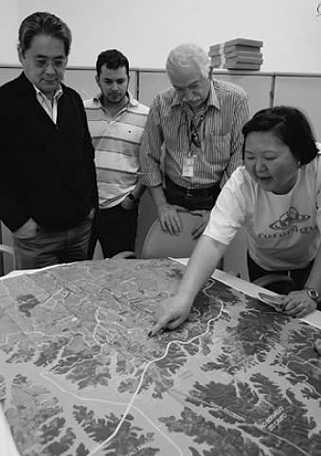Japan's Official Development Assistance White Paper 2011
Section 5 Cooperation Related to the Environment/Climate Change and the Utilization of Japan's Technology in Developing Countries
Climate change affects the living environment in a variety of ways, including droughts, flooding, and other abnormal weather, and rising of sea levels caused by global warming. To deal effectively with these issues, funding, technology, knowledge, infrastructure, administrative ability, and other aspects of the socio-economic environment must be improved. (Note 8) Such funding, technology, and knowledge is particularly lacking in developing countries, resulting in a tendency to lag behind in taking action against climate change. Because of this, when, for example, a natural disaster occurs, the response is insufficient or delayed, so the damage expands. In 2010, Japan provided grant aid to 25 countries, chiefly in Asia and Africa, as funding to procure the equipment and materials needed for disaster countermeasures, in order to improve the ability of such developing countries to deal with natural disasters. When Cambodia suffered torrential rainfall, etc., in 2011, Japanese-made heavy equipment that was provided through this type of cooperation was used to repair levees that had collapsed due to the flooding, etc., and the Cambodian government expressed its gratitude.
In addition, regions that are susceptible to the effects of climate change are also susceptible to water shortages due to low rainfall, drought, etc., so ensuring access to safe water is also an issue. In 2010, grant aid was implemented to provide funds to procure a plant to desalinate highly saline ground water with Japanese technology to ensure a stable supply of water in a city in southern Tunisia, a desert region with a drastic shortage of water.
Greenhouse gases, a cause of climate change, are not only emitted by the developed world. Over half of the world's emissions come from developing countries that do not have an obligation to reduce emissions as stipulated in the Kyoto Protocol. To achieve a worldwide reduction in emissions, it will be necessary to strive to reduce greenhouse gases from those developing countries as well. To accomplish this, the developed countries must proactively support the efforts of developing countries that lack the capabilities and funds to make such reductions.
In 2010, Japan provided yen loans for the building of geothermal power plants in Kenya, which suffered from a serious power shortage due to a decrease in the hydroelectric power supply caused by a large-scale drought. The use of Japan's superior steam turbines for geothermal power generation in this cooperation is expected not only to stabilize Kenya's electrical power supply, but also to reduce greenhouse gas emissions to a level lower than those of a thermo-electric power plant of a similar scale.
Many developing countries are facing a variety of environmental problems, not only climate change, but also air pollution due to rapid economic growth and urbanization, and water contamination caused by the lack of sufficient sewer systems, etc. In 2009, Japan provided an ODA loan for a high-speed urban railway system in the Jakarta metropolitan area in Indonesia, where traffic congestion and the resulting air pollution have become severe. In addition, that same year, Japan provided an ODA loan for a sewage facility in Port Moresby, Papua New Guinea, which has suffered from water contamination along the coast caused by the flow into the ocean of sewer water that had not been sufficiently processed.
There are many cases in which Japanese companies have participated and Japan's superior environmental and infrastructure technology has been applied in cooperation related to the environment and climate change in developing countries.
Through the implementation of such activities through a partnership between government and the private sector, Japan's excellent technology will be utilized in even more developing countries. Further, Japan will continue to provide such aid, with the expectation that it will be helpful in efforts to deal with climate change and other environmental issues in developing countries.

The aim of the "Environmental Improvement Project in the Basin of Lake Billings" in Brazil is to improve sewer systems, improve the lives of the people living around the lake, and protect the environment (Photo: Shinichi Kuno/JICA)
Notes:
(8) As described here, construction of seawalls, improvement of the nutritional content of soil, and prevention of communicable diseases, for example, as measures against climate change and the resulting rise in temperatures or sea levels, etc., are referred to as "adaptation." On the other hand, efficient use of energy, energy conservation, collection/accumulation of carbon dioxide, increase of carbon sinks, etc., and other measures that take time but are aimed at fundamental resolution are referred to as “mitigation.”
